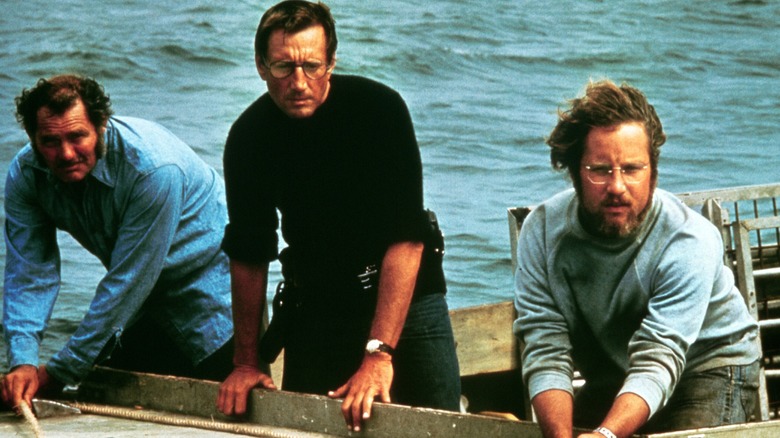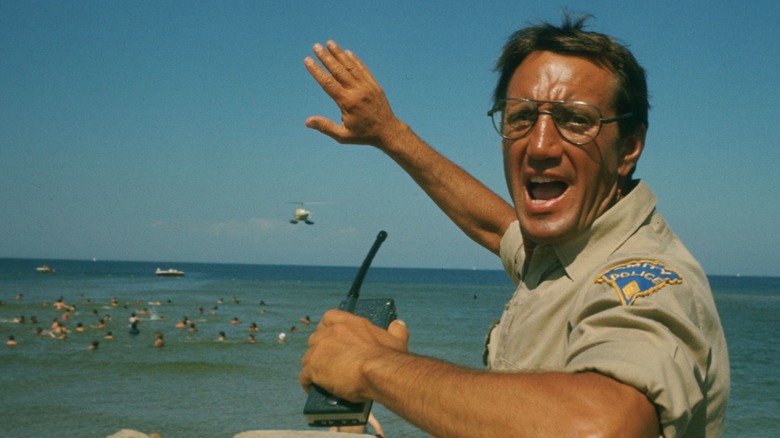Steven Spielberg Made A Big Mistake When He Shot Jaws (But He'd Do It Again)
It is a miracle that "Jaws" was even made. Steven Spielberg's 1975 thriller celebrates its 50th anniversary this year, still serving as the blueprint for summer blockbusters that boast impeccable artistry. Featuring John Williams' iconic soundtrack and incredible performances across the board, "Jaws" culminates in one of the most flawless monster reveals in the genre.
However, the making of "Jaws" was anything but perfect, as everything from insufficient starter budgets to botched schedules led to a greatly troubled production. When Spielberg came on board to direct, the project was in an especially precarious position: the budget had tripled, the schedule was beefier than the time allotted for filming, and the mechanical shark props malfunctioned time and again. Amid endless re-shoots and delays, Spielberg made a huge mistake by underestimating a critical aspect of the film's setting: the ocean.
Filming at sea, after all, is no joke. Unpredictable weather conditions aside, random boats can sail into the frame and ruin takes, and seawater can end up damaging expensive equipment. I'm sure Spielberg was aware of these potential obstacles before filming, but he might have overestimated the collective efforts of a film crew against the whims of an untameable force of nature. In an interview with Entertainment Weekly, Spielberg acknowledged this naivety, stating that it was "foolhardy" of him to think he could conquer the elements:
"I was naive about the ocean, basically. I was pretty naive about Mother Nature, and the hubris of a filmmaker who thinks he can conquer the elements was foolhardy, but I was too young to know I was being foolhardy when I demanded that we shoot the film in the Atlantic Ocean and not in a North Hollywood tank. But had I to do it all over again, I would have gone back to the sea because it was the only way for the audience to feel that these three men were cast adrift with a great white shark hunting them."
Although filming "Jaws" in the Atlantic Ocean was nothing less than an uphill battle, it undoubtedly paid off.
The might of the ocean was the greatest production hurdle for Spielberg's Jaws
Although the emotional and dramatic heft of "Jaws" lies in the sequences set in the ocean, the ones set on land are equally important to evoke key symbolic juxtapositions. Apart from setting the stage for the horrors that emerge from the tides, the land sequences convey a sense of familiarity, where even moments of crisis can be mitigated to an extent.
Spielberg shot most of the land scenes in Martha's Vineyard, a location that was significantly easier to navigate than the turbulent ocean. Speaking to Vanity Fair, Spielberg described shooting on location as "perfect," as the quaint whaling town was not just chosen for its picturesque setting, but also for its proximity to the ocean. A shark sled was installed thirty feet below the ocean surface, which facilitated the installation of the shark apparatus.
Spielberg and co. didn't anticipate the number of problems they would be inundated with once they were at sea. Even when equipment started malfunctioning, Spielberg was stubbornly rooted in his belief that believability was crucial to the film's horror-thriller context, bolstering the anxiety that would haunt audiences throughout. As a result, everything had to be shot in a way that would sell the illusion that those aboard the Orca were truly trapped, where they couldn't simply turn the boat and escape. In the Vanity Fair interview, the director did admit that everyone would probably have an easier time filming inside a tank, but that would have robbed "Jaws" of its visceral appeal:
"If we had shot the film in a tank without strong tides and without waves and wind, we would have had an easier time. I kept remembering a movie which I had loved Spencer Tracy in, called 'The Old Man and the Sea' [1958], but how it was so stylized and so impressionistic. It looked like a lake, like a studio tank. And the wild sunsets were obvious painted backdrops. I didn't want 'Jaws' to look like that. The audience would not have connected with the movie unless it looked real, and that's why I insisted on shooting the picture on open sea in the Atlantic Ocean."
While "Jaws" had an admittedly grueling production, what we see on screen feels so palpably real and tense because of it. The film is nothing short of a cultural touchstone that dares to place us right in the middle of a dangerous, isolated location and forces us to look within. While the big, bad aquatic monster is an immediate, unconquerable threat, "Jaws" dissects systemic human greed and personal hubris, identifying the horror that lurks within the layers of social ills.

